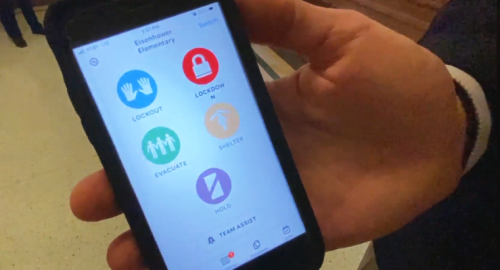This article originally appeared on KXAN News. To view the original article, click here.
The Committee Substitute to House Bill 204 requires districts to implement a multi hazard emergency operations plan based on guidelines set forth by the Texas School Safety Center, the governors office of homeland security and the states education commissioner.
A key component of the bills requirements is a panic alert device either physical or digital to trigger communication with law enforcement.
The legislation is dubbed Alyssas Law after Floridian Alyssa Alhadeff who died in the Parkland high school shooting in 2018.
So vivacious, loved life, was a soccer player just an amazing person, and I miss her so much, her mom, Lori said Tuesday. Lori Alhadeff traveled to Texas to testify on the legislation.
We want to empower teachers to have their panic button so if theres a life-threatening emergency situation on campus, they can push a button, and its directly linked to law enforcement, Alhadeff said.
The bill was slated for a hearing in the House Public Education Committee on Tuesday.
Alyssa, unfortunately, lost her life, because they weren’t able to save her in time, said bill author State Rep. Shawn Thierry, D-Houston.
After the mass shooting in Santa Fe, I was just very, very overwhelmed, Thierry, the mom of a second-grader, said in an interview.
Our courts have more security, our state capitol has more security, our airports,Thierry said. How can we have our most vulnerable population be solid, so unprotected, in the event of a mass shooting or other emergency.
HB204 requires districts the panic alert device to allow for immediate contact with district emergency services or emergency services agencies, law enforcement agencies, health departments, and fire departments, according to the bills committee substitute.
The language requires junior college districts include a panic alert device or a phone in the classroom.
Similar legislation passed in Florida and has taken effect in New Jersey.
If an active shooter walked into your school right now and started roaming the halls, attacking students and shooting them? Would you have an ability immediately to contact law enforcement and first responders to let them know exactly where that shooter is?Thierry said. If they’re roaming around, if a teacher had a heart attack in a classroom, how would you be able to communicate immediately?
One concern about this legislation is the cost to implement. According to a state financial analysis, there would be no major fiscal impact to the state, but local schools would need to purchase, install and maintain the panic button systems.
10% of Texas school districts use the services of Texas-based Raptor Technologies for its emergency alert software, according to CEO Gray Hall. 80% of Texas school districts use Raptors visitor management system.
Taking action through this app, we make direct contact with first responder agencies,Hall said. With a few more clicks after initiating the initial emergency, you can provide the context needed so that first responders can immediately add help when they arrive at the scene.
Raptors full suite of software costs approximately $2,000 per campus, per year, Hall said.
According to the fiscal analysis, it is assumed that the costs associated with the bills provisions relating to requiring school districts and open enrollment charter schools to provide a landline telephone or panic button in every classroom could be absorbed using existing resources.
The costs associated with this requirement would vary based on a schools size and existing infrastructure beginning with the 2023 -24 school year,the analysis stated.
State Rep. Jacey Jetton, R-Sugarland, a father of two school-aged children, had not read the bill as of Monday afternoon but said he would want to make sure districts could afford to implement the mandate.
I would definitely need to see what the fiscal impact would be to make sure that the schools are able to handle it, and if not, then make sure that the state has ability to fund it right now, too, Jetton said.
Some districts previously turned to bond measures to cover costs.
Lubbock ISDs 2018 bond focused mainly on security measures. That year, the district allocated $50 million for safety and security with $40 million of that for security devices. The district spent $13 million updating IT closets and public address systems in its schools to ensure widespread messaging capability on campuses.
Lubbock ISD built in redundancies into its system, including two-way radios to connect from classrooms to the main office of each campus, and each teacher has access to an emergency preparedness app called Navigate360 to allow them to call for assistance in multiple ways.
You never know what system might go down at any given time, depending on whats happening. And so we also want to make sure that thats built in too,Lubbock ISDs director of school safety and security, Stacy Carter, said in an interview.
Thierry said districts could use their state-funded school safety allotment to purchase this type of technology.
Last session, the Texas Legislature gave $100 million to school districts to do exactly this,Thierry said. Most schools haven’t even had an opportunity to tap into their allotment.
So the money is there, the technology is there, all we have to do is pass the bill and implement, she added.
Some Texans worried the legislation would strip local decision-making power from districts by setting the statewide requirements.
(It) eliminates the local control of school districts and an open enrollment charter schools to decide for themselves what is the best solution, whether that be a radio system, voice over IP telephone, cellular phone, or even whats been proposed here in conversation, Kerri Brady, a member of the Texas School Safety Center board, said during her testimony. That is a local decision currently in the bill, and there are concerns that that local control is being removed for local school districts and open enrollment charter schools.
Thierry said setting the standard would set schools up for success.
This is a simple tool that schools can use, that will save lives, she said.





